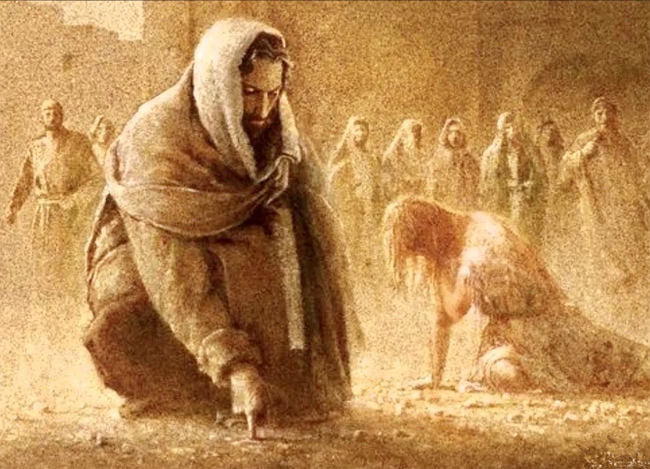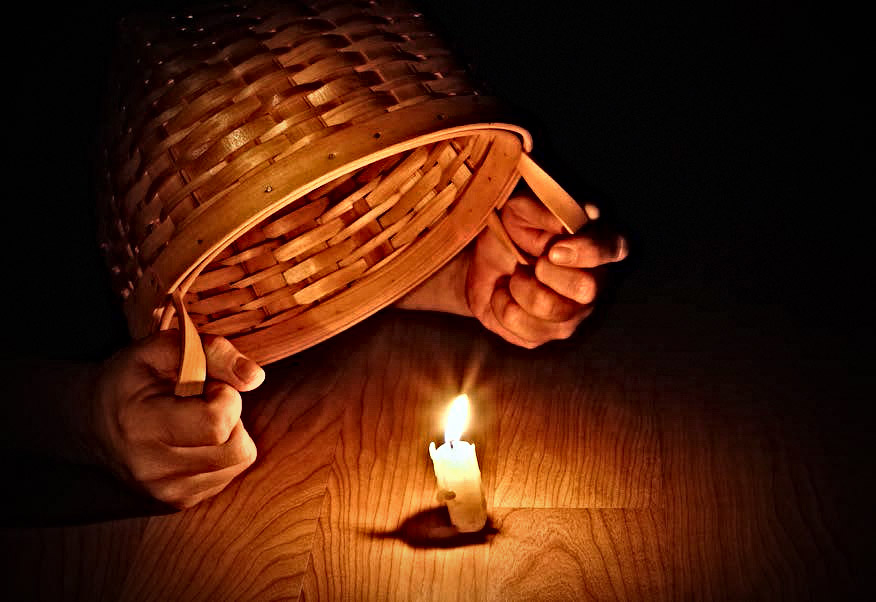Christian Art | The Woman Taken In Adultery
John 8: 1-11 – Lent Week 5, Sunday (Audio Bible, King James Version, KJV, Spoken Word)
1 JESUS went unto the mount of Olives.
2 And early in the morning he came again into the temple, and all the people came unto him; and he sat down, and taught them.
3 And the scribes and Pharisees brought unto him a woman taken in adultery; and when they had set her in the midst,
4 They say unto him, Master, this woman was taken in adultery, in the very act.
5 Now Moses in the law commanded us, that such should be stoned: but what sayest thou?
6 This they said, tempting him, that they might have to accuse him. But Jesus stooped down, and with his finger wrote on the ground, as though he heard them not.
7 So when they continued asking him, he lifted up himself, and said unto them, He that is without sin among you, let him first cast a stone at her.
8 And again he stooped down, and wrote on the ground.
9 And they which heard it, being convicted by their own conscience, went out one by one, beginning at the eldest, even unto the last: and Jesus was left alone, and the woman standing in the midst.
10 When Jesus had lifted up himself, and saw none but the woman, he said unto her, Woman, where are those thine accusers? hath no man condemned thee?
11 She said, No man, Lord. And Jesus said unto her, Neither do I condemn thee: go, and sin no more.
Jesus goes to the Mount of Olives on a number of occasions to pray. It is good for us now to witness Jesus praying. When we pray, we pray with Jesus and according to his example.
We see again in this passage of the Bible how the people come to Jesus to hear his teachings. It must be very strange for them, to hear Jesus’ word. Nevertheless they do come and Jesus gives his time to cater for their needs.
Throughout this Bible passage, Jesus maintains an attitude of prayer. He is in communion with his Father. We should understand Jesus’ mercy in this light.
The scribes and the Pharisees bring the woman caught in adultery to test Jesus. According to the Law, she is to be stoned. It seems there is no way to avoid this punishment. The Law is clear.
Also according to Law, it is those who witnessed the crime who should throw the first stones, then the others would join in, making this death penalty a communal event, the judgement shared by all.
Jesus uses this legal detail to change our understanding of the Law without violating it. In one of the most striking visual passages of the Bible, such as we can imagine having been handed down with wonder through the oral record, before the Gospels were committed to writing, Jesus remains calm, still in prayer, writing we do not know what on the ground, very collected. It is as though he does not hear those who try to tempt him.
Jesus knows his tempters. He knows their and our humanity. Jesus, who will judge us, will not now do anything other than show this woman mercy and help her out of her sin. ‘He that is without sin among you, let him first cast a stone at her.’
And so they leave. Every person who was come here to kill a human being now examines his own conscience and finds himself in need of contrition and mercy.
It is a beautiful scene. Jesus and the woman who has sinned are left alone. The sinner and Mercy are now together. The scribes and the Pharisees have been accused by their own consciences and have been found unworthy to judge. They need to consider the state of their own souls and not anyone else’s.
‘Woman, where are those thine accusers? hath no man condemned thee? Neither do I condemn thee: go, and sin no more.’
May we pray for Christ’s forgiveness and approach him with our sins, freely confessed, in hope and confidence. May we give ourselves utterly to God, for He is good.
‘First he offered sacrifice here on earth when he underwent his most bitter death. Then, clothed with the garments of immortality, he entered the holy of holies taking his own blood, that is, he went into heaven… A share in this holy, eternal sacrifice is given to all who have undertaken true contrition and penance for their sins.’ St John Fisher
King James Version | Audio Bible KJV | Endnotes
Go And Sin No More | The Woman Taken In Adultery
The scribes and Pharisees who brought the woman caught in adultery to Jesus were focused on upholding the Law of Moses, which required stoning as punishment for adultery. However, Jesus challenged their legalistic approach by insisting that the one without sin should cast the first stone. By doing so, Jesus demonstrated that the Law is not the ultimate authority, and that mercy and compassion are more important than strict adherence to the Law.
John 8:1-11 is a powerful and provocative story that invites us to reflect on the nature of the Law, the person of Jesus, and the possibilities for renewal and transformation in our lives. At its core, this story challenges us to move beyond a narrow legalistic approach to the Law and instead embrace a more spiritual and mystical understanding that is grounded in the person of Jesus.
As we have seen, there are interpretations of the role of the Law in Christian theology. Some scholars emphasize the mystical and spiritual dimensions of the Law, as seen in the Gospel of John, which portrays Jesus as embodying the Law in his own person and challenging his listeners to go beyond a superficial adherence to the letter of the Law. Others emphasize the importance of Jesus as a teacher who upholds and extends the Law, as seen in various Christian traditions, which seek to interpret the Law in light of Christ’s teachings and example.
In the story of the woman caught in adultery, we see Jesus engaging with the Law in a powerful and transformative way. He does not simply reject the Law or dismiss it as irrelevant, nor does he simply enforce the letter of the Law by condemning the woman to death. Instead, he challenges his accusers to reflect on their own sinfulness and to recognize the mercy and compassion that God offers to all who seek it.
In this sense, Jesus embodies the role of the high priest who offers a new and superior sacrifice for sin, replacing the old system of animal sacrifices and ritual purity. He offers not just forgiveness, but also renewal and transformation, inviting us to move beyond a legalistic approach to the Law and embrace a more spiritual and mystical understanding that is grounded in his own person.
This is particularly relevant during Lent, a time when Christians are invited to reflect on their own sinfulness and to seek renewal and transformation through prayer, fasting, and acts of charity. The story of the woman caught in adultery reminds us that we are all sinners in need of God’s mercy and that through Jesus we can experience forgiveness, renewal, and transformation.
At the beginning of the passage, we are told that the woman was caught ‘in the very act’ of adultery, and brought before Jesus by a group of scribes and Pharisees who seek to trap him. They ask him whether the woman should be stoned, in accordance with the Law of Moses, which mandates this punishment for adultery.
Jesus responds by writing on the ground with his finger, and then saying to the accusers: ‘He that is without sin among you, let him first cast a stone at her.’ (John 8:7, KJV).This statement is interpreted as an invitation to introspection and self-reflection, reminding the accusers that they too are imperfect and have committed sins. As a result, they all depart one by one, leaving only Jesus and the woman.
Jesus then turns to the woman and asks her if anyone has condemned her. When she responds in the negative, he says to her: ‘Neither do I condemn thee: go, and sin no more.’ (John 8:11, KJV) This statement is often understood as an expression of Jesus’ mercy and forgiveness, as well as his rejection of legalistic interpretations of the Law.
The Gospel of John presents Jesus as the ‘Word made flesh’ (John 1:14), which has been interpreted by scholars as referring to Jesus as the embodiment of the Law, or the embodiment of God’s wisdom and truth. In this view, Jesus does not over-ride or abolish the Law, but rather fulfils it by embodying its principles and living them out in his life and teachings.
In this passage, Jesus confesses himself as being superior to the Law that was given to the Pharisees. Jesus is Son of the Father. As such, Jesus has the right to fulfil and perfect the Law. This does not exclude thought of sin and judgement. Rather, we are directed to faith in Jesus as the way. Jesus confesses himself as our salvation from the bonds of legalistic Law. Jesus is God’s mercy.
The question remains: What was Jesus writing in the dust with his finger? Perhaps that is for us, each Christian to write for himself/herself. We know our own needs. Even we might think of the opening of Lent: ‘For dust you are and to dust you shall return.’








